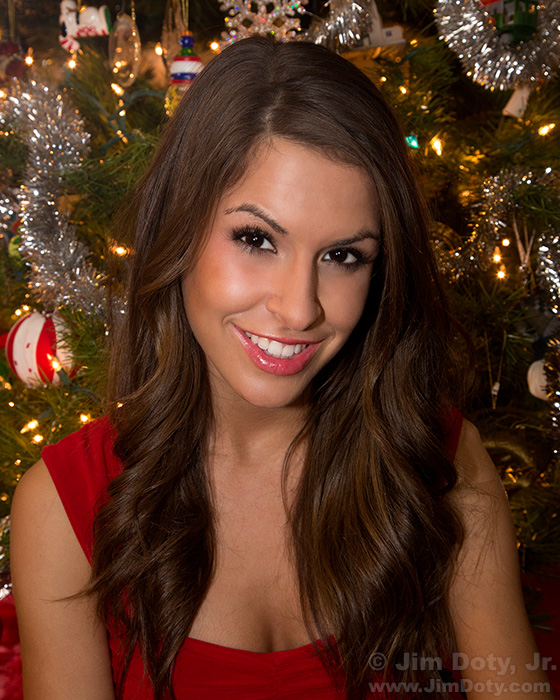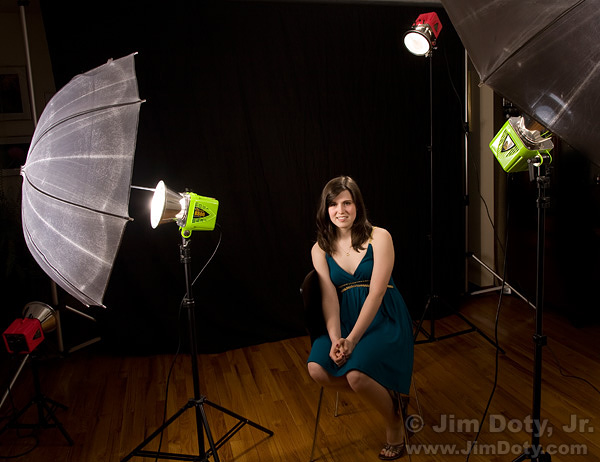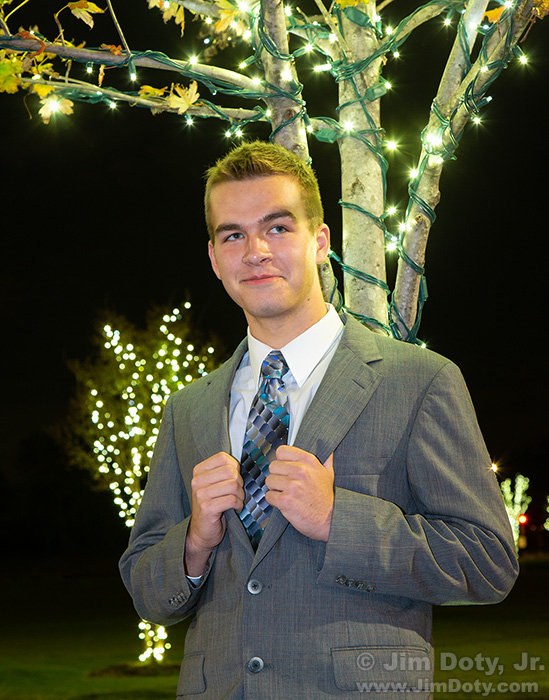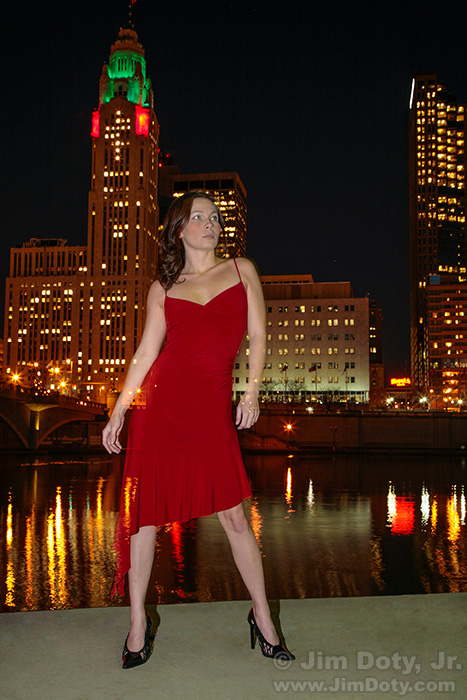On Christmas eve I found myself doing Christmas portraits for Kristina’s portfolio. She is a friend of mine who is a model and actress in L.A. I had to improvise a bit with the lighting and I needed to get the right mix of flash and ambient light for the look I wanted.
Originally posted January 20, 2014. Revised, expanded, and re-posted December 17, 2024.
The secret to flash plus ambient light exposures with Christmas lights is to use a long shutter speed. Your studio flash or on-camera flash can give you a good exposure for the portrait but the typical shutter speed for a flash exposure (usually between 1/60 and 1/250 second) means the Christmas lights will barely show up, if at all. Christmas lights need a long exposure. So the secret to flash portraits plus Christmas lights is to use a long shutter speed so the Christmas lights show up in the photo.
For this portrait of Kristina I did everything in manual mode. I used a studio flash with an umbrella (camera left) as the “main” light. Studio flash units are manual only with a slider or other control to change the power output to match the aperture you want to use. I triggered the slave on the studio flash with an on-camera flash which was the “fill” light. It was in manual mode with the power dialed down.
My preferred aperture was f/8 to give me enough depth of field for Kristina’s face but leave the tree slightly blurred but clearly recognizable.
My usual preference when using a studio flash is to set the camera ISO to 100 for maximum image quality, and use a fast shutter speed. But for this photo I needed to “drag the shutter” (use a long shutter speed) to record the lights on the Christmas tree. Even with a shutter speed of 1/60 second at ISO 100, the Christmas lights would barely show up and the tree would look too dark.
At ISO 100 with an aperture of f/8, the correct shutter speed to record the Christmas tree the way I wanted turned out to be 1 second. I rarely ask anyone to remain totally motionless for 1 second unless I want some ghosting from subject motion, so I boosted the ISO to 800, giving me an ambient light shutter speed of 1/8 second for the tree. At that shutter speed there is less chance of subject ghosting in a portrait shoot provided you ask the subject not to move after the flash fires. At 1/8 second it is best if the camera is on a tripod.
When using a manual studio flash, the fastest and most accurate approach to metering is to use an incident light meter and set the power of the flash accordingly. An alternative is to do some test shots, paying careful attention to the histogram (see the link below for instructions). Do not trust the LCD image on the back of your camera to give you a truly accurate exposure.
You don’t need studio lights to do portraits. You can use an on-camera flash unit in automatic or manual mode.
This portrait of my grandson Andrew was taken outside after his honor society induction ceremony at a restaurant in Fort Worth. I wanted to use the outdoor trees with the Christmas lights as a back drop for a festive, holiday look. I used an on-camera flash in automatic mode. This gave me a nice exposure for Andrew but the Christmas trees were very dark. I had to dial the shutter speed to 0.3 second for the Christmas lights to show up.
For this portrait of Sarah I used an on-camera flash. The flash was set to automatic mode and for this image it did a fine job. I had to experiment to get the right shutter speed for the city lights to show up. It took 2.6 seconds. I had Sarah move a bit after the flash fired so we would get a bit of ghosting in the image. As a result you can see some of the city lights through Sarah’s arms and dress.
Depending on the size and reflectivity of your subject, automatic flash sometimes gives you a subject that is too light or too dark. To fix that, change the dial for the flash exposure compensation until your subject looks just right.
The “flash exposure compensation” system in most good cameras is a totally separate system from the “exposure compensation” system. With separate systems, changing one does not change the other. That is a good thing.
Photo Data, Kristina: Canon EOS 5D Mark III on a Gitzo tripod. Canon EF24-105mm f/4L IS USM lens at 50 mm. Canon 550 EX flash on camera in manual mode (at a low power setting) to trigger the studio flash. Alien Bees studio flash with an umbrella. f/8, 1/8 second, ISO 800.
Photo Data, Andrew: Canon EOS 5D Mark III, handheld. Canon EF24-105mm f/4L IS USM lens at 70 mm. Canon 550 EX flash on camera in automatic mode. f/8, 0.3 second, ISO 800.
Photo Data, Sarah: Canon EOS 5D on a Gitzo tripod. Canon EF24-105mm f/4L IS USM lens at 40 mm. Canon 550EX speedlite set to ETTL auto exposure. f/11, 2.6 seconds, ISO 400.
Links
Using the Histogram to Check Studio Flash Exposures
How to Photograph Christmas Lights with Your DSLR, ILC, or Smartphone
In my book Digital Photography Exposure for Dummies you can learn all about portraits, depth of field, using an on-camera flash in manual mode, using studio lights, balancing main and fill lights for the lighting ratio you want, metering with an incident light meter, using a histogram to check exposure, and mixing flash with ambient light. Digital Photography Exposure for Dummies is one of the highest rated photography books at Amazon.com. You can learn more here and order it at Amazon.com.




